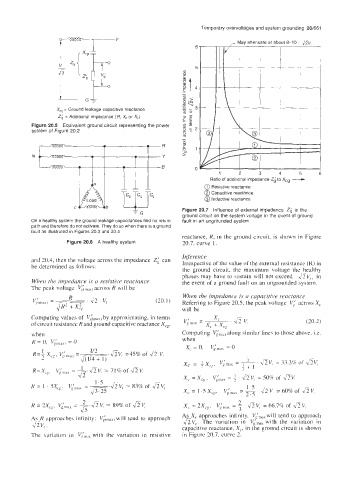Page 701 - Industrial Power Engineering and Applications Handbook
P. 701
I emporary overvoltages and system grounding 201661
May attenuate at about 6-10 . &v,
I
XcQ = Ground leakage capacitive reactance - ?--
Z; = Additional impedance (R, X, or X,)
Figure 20.5 Equivalent ground circuit representing the power
system of Figure 20.2
1 2 4 5
Ratio of additional impedance i'i to Xcg --c
@ Resistive reactance
@ Capacitive reactance
@ Inductive reactance
Figure 20.7 Influence of external impedance Zb in the
ground circuit on the system voltage in the event of ground
On a healthy system the ground leakage capacitances find no return fault in an ungrounded system
path and therefore do not activate. They do so when there is a ground
fault as illustrated in Figures 20.3 and 20 4
reactance, R, in the ground circuit. is shown in Figure
Figure 20.6 A healthy system 20.7, curve 1.
Inference
and 70.4, then the voltage across the impedance 2; can
be determined as follows: Irrcspcctive of the value of the external resistance (R) in
the ground circuit, the maximum voltage the healthy
phases may have to sustain will not exceed &V,, in
When the impedance is a resisthie reactance the event of a ground fault on an ungrounded system.
The peak voltage %:,,,dxj across R will be
When the impedance is n cnpacirive reacfanct
(20.1) Referring to Figure 20.5, the peak voltage Vl' across X,
will be
Computing values of Virnah) by approximating, in terms
' 43 v:
xc
of circuit resistance Rand ground capacitive reactance XCg, v;max = x, +xcg (20.2)
when Computing VinlaXalong similar lines to those above. i.e.
K = 0, G,,lJyl 0 when
x, = 0, = 0
x, = x,, , v,',,, = + . av, 50% of dv,
=
1.5
x, = 1.5 x,,, Vi",,, = 2.5 aV, = 60% of &V,
2 2
R = 2X,,, V,',,,, = --.fiV, 2- 89% of fiV, X, = 2Xc, . Vimax = - fi V, = 66.7% of $V,
Js 3
As K approaches infinity: will tend to approach As X, approaches infinity. Vimaxwill tend to approach
AV, . aV,. The variation in V,',,, with the variation in
capacitive reactance, X,, in the ground circuit is shown
The variation in r/,',,,,,, with the variation in resistive in Figure 20.7, curve 2.

